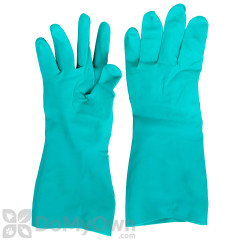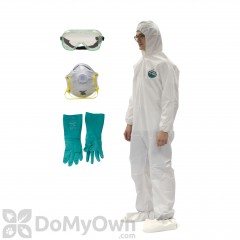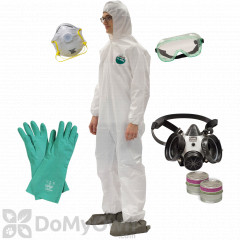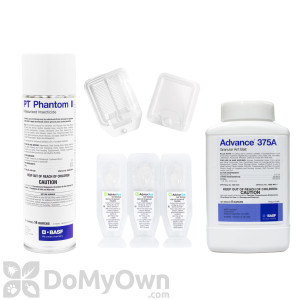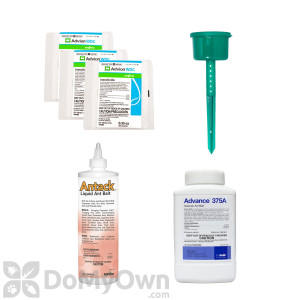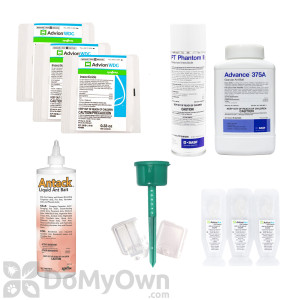Little Black Ant Control
Little Black Ants are jet-black in color, with a 12- segmented antenna ending in a 3-segmented club. The pedicel (bridge between abdomen and thorax) has 2 segments. The Little Black Ant worker is about 1/16th inch in length, while the queen is twice that size. The Little Black Ant is native to the United States and common throughout, however the heaviest populations are found in the eastern half of the country.
Step 1) Find the Entry Point or Colony
Little Black Ants are highly adaptable when it comes to nesting, and nests are commonly found both indoors and outdoors, in a variety of climates. Little black ants prefer to make a home of decayed woods, but will also build nests in cement cracks, under stones, or in open lawns. When you first notice invading ants, they may form an obvious trail which you can easily follow to find exactly where the ants are entering. If the ant trail and entry point is NOT obvious, try the following Honey & Peanut Butter Bait Method:
1) Place a large dab of honey and a dab of peanut butter side by side on a flat note card or piece of tin foil.
2) Place the card or foil in a corner on the floor close to where you notice the greatest ant activity.
3) If the activity is in several places, put out more than 1 card.
Within about two hours, the ants will locate the food source, and form a steady trail of workers to and from the colony to the food source. You should then be able to follow the trail visually to the point where the ants are entering. This may be a crack in a baseboard, a doorframe, or window sill. Ideally, you will be able to follow the trail all the way to the ant colony.
Step 2) Treat the Nest or Colony
There are several ways to treat an ant colony, depending on its location. If you were unable to locate the colony, skip to step 3.
- Nests in Structural Voids should be treated with Delta Dust Insecticide. If the existing point of entry is not large enough to inject the dust, a hole may be drilled and later repaired. Apply Delta Dust in a thin layer (generally 2 to 3 puffs) using a Hand Duster.
- Nests in Wood such as structural timbers, fence posts, tree holes, stumps, or logs, should be treated the same as those in structural voids, using Delta Dust Insecticide and a Hand Duster. Holes may be drilled for easier access.
- Nests in Soil (includes ant colonies located in lawns, flower beds, or underneath stones and rocks)- Drench mound with a water-based liquid insecticide such as Cyper WSP, Suspend SC, or Talstar P. You will also need a Chapin SureSpray 1 Gal Sprayer for mixing and application. Usually only a few ounces is needed, but follow the product label.
- Nests in Landscape Mulch may be treated with a liquid insecticide such as Cyper WSP, Suspend SC, or Talstar P. You will also need a Chapin SureSpray 1 Gal Sprayer for mixing and application. Since mulch is thick and difficult to penetrate, first rake back the mulch to expose the ant colony before treating.
- Nests in Slab Foundations are typically difficult to access, and baits would be the ideal treatment (see step 4). If baiting is unsuccessful, a number of holes may be drilled in the foundation through which a termiticide labeled for application under slab foundations can be used. Termidor SC is an excellent option for such cases.
- Nests in Stack of Lumber, Bricks, or Other Material can be treated by unstacking the materials in order to expose the colonies, then drenching the mound(s) with a liquid insecticide such as Cyper WSP, Suspend SC, or Talstar P, You will need a Chapin SureSpray 1 Gal Sprayer for mixing and application.
Step 3) Baiting
Baiting is the most effective form of control for Little Black Ants. Try using a sweet-based bait first, such as Maxforce Fleet Ant Bait Gel. If the ants do not seem to be taking the bait, switch to a protein-based bait such as Advance 375A Select Granular. It may take 3 to 5 days to see results with baiting, but it is almost always more effective than spraying indoors because the ants have time to take the bait back to their nests, which will eventually lead to colony elimination. Be sure to read the product label for tips on usage, application rate, and bait placement, etc.
Step 4) Treat the Outside Perimeter
If several weeks have show baiting to be unsuccessful, you may also want to treat the outside perimeter of your home with a liquid residual insecticide. Treat at least a 3 foot band near the foundation as well as around window and door frames where ants enter to create your protective barrier. We recommend using Cyper WSP, Suspend SC, or Talstar P. You will also need a Chapin SureSpray 1 Gal Sprayer for mixing and easy application. For perimeter application rates and mixing instructions, be sure to read the product label thoroughly. Most liquid residuals remain effective for 8 to 12 weeks.
Additional Methods for Ant Prevention & Control
After you have applied the appropriate pesticide chemicals, these additional non chemical methods will help you to maintain control and prevent future ant infestations:
- Practice good sanitation.
- Limit food preparation and consumption to one or two areas of the home that are cleaned daily. Ants will be less likely to invade if food sources (like crumbs and spills) are not available.
- Eliminate gaps and cracks in the foundation, baseboards, window frames, and door frames with caulk or other appropriate material to eliminate ant entryways.
- Materials such as stacked or piled lumber, stones, bricks, leaf litter, heavy mulch, and other debris that serve as potential ant harborages should be removed as far from the structure as possible.
- Trim the branches of trees, shrubs, and other vegetation that may serve as ant highways so they do not touch the structure.
- Repair leaky pipes and faucets.
Products
All Ant Control products
